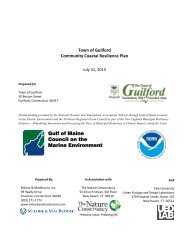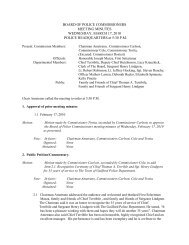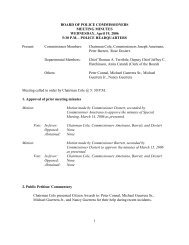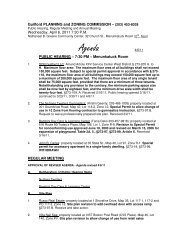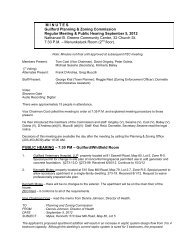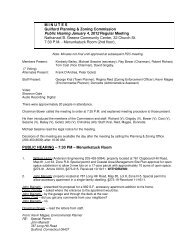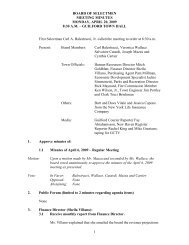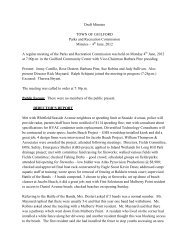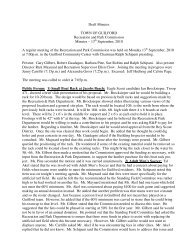Natural Resource Inventory and Assessment - Town of Guilford
Natural Resource Inventory and Assessment - Town of Guilford
Natural Resource Inventory and Assessment - Town of Guilford
Create successful ePaper yourself
Turn your PDF publications into a flip-book with our unique Google optimized e-Paper software.
Section J SIGNIFICANT NATURAL RESOURCE AREAS<br />
J.1 Introduction<br />
See separate Map Atlas for map references<br />
In reviewing <strong>and</strong> assessing maps <strong>of</strong> resources individually <strong>and</strong> in combination with each other, certain<br />
areas emerged as particularly outst<strong>and</strong>ing or significant. These are <strong>Guilford</strong>’s best examples <strong>of</strong> rivers,<br />
waterbodies, wetl<strong>and</strong> complexes, large grassl<strong>and</strong>s, forests, wildlife movement corridors, <strong>and</strong> locations <strong>of</strong> rare<br />
species <strong>and</strong> natural communities. These are places that have maintained their ecological integrity; that is,<br />
the mosaics <strong>of</strong> different habitats <strong>and</strong> the processes that sustain them over the long term are relatively intact<br />
(e.g., water flows, movement <strong>of</strong> plants <strong>and</strong> animals). Termed Important Ecological Systems in the NRIA,<br />
taken together they form Significant <strong>Natural</strong> <strong>Resource</strong> Areas (SNRAs).<br />
Areas composed <strong>of</strong> habitat mosaics, including forest, fields, <strong>and</strong> various types <strong>of</strong> wetl<strong>and</strong>s are critical to<br />
animals that use different habitats at different points in their life cycles. Areas that include diverse habitats<br />
also support a greater variety <strong>of</strong> plants <strong>and</strong> animals, <strong>and</strong> these species will be more likely to persist over<br />
time.<br />
J.2 Components <strong>of</strong> Important Ecological Systems<br />
Forests – Map J-1<br />
• Seven forest blocks are significant because they are large <strong>and</strong> relatively intact, not fragmented<br />
by paved roads or development. Many also capture <strong>Guilford</strong>’s most intact wetl<strong>and</strong> complexes<br />
<strong>and</strong> include the headwaters <strong>of</strong> our significant watercourses.<br />
• Bobcat, forest-interior birds (e.g., warblers, veery, wood thrush), <strong>and</strong> other native <strong>Guilford</strong><br />
wildlife require large, intact forests to forage <strong>and</strong> hunt, protect their young from predators <strong>and</strong><br />
parasites (e.g., domestic cats, raccoons, cowbirds), <strong>and</strong> establish new territories.<br />
• Although wooded backyard lots also have trees, they are not equivalent. An intact forest functions<br />
differently <strong>and</strong> can support interior-forest animals <strong>and</strong> plants that these woodl<strong>and</strong>s cannot.<br />
• Given its location, the coastal hardwood forest on Sachem’s Head is important because it is<br />
uniquely influenced by the coast (e.g., salt spray, storms).<br />
Sources: U.S. <strong>Natural</strong> <strong>Resource</strong> Conservation Service (NRCS) L<strong>and</strong> Use/L<strong>and</strong> Cover map for <strong>Guilford</strong><br />
(See Map 2), The Nature Conservancy Northeast forest block map<br />
River Systems – Map J-2<br />
• Included are <strong>Guilford</strong>’s healthiest aquatic (in-water), riparian (stream edge), <strong>and</strong> floodplain<br />
habitats. They are situated within relatively intact l<strong>and</strong>scapes <strong>and</strong> support species that<br />
require particularly clean water (e.g., trout, bottom-dwelling insects) or contiguous habitat<br />
(e.g., migratory fish, river otter).<br />
• The West River serves as a critical north-south link for wildlife movement, despite having been<br />
degraded along some <strong>of</strong> its reaches.<br />
• Watercourses are bounded by a 300-foot riparian corridor, the width that the scientific<br />
community has found is required to support wildlife habitat functions, remove pollutants <strong>and</strong><br />
sediment, regulate temperature, <strong>and</strong> stabilize banks. (See Appendix J-1.)<br />
While the particular systems included within the SNRA are outst<strong>and</strong>ing, all <strong>of</strong> <strong>Guilford</strong>’s streams are<br />
important <strong>and</strong> reflect the quality <strong>of</strong> their watershed’s surface <strong>and</strong> ground water.<br />
Sources: NRCS L<strong>and</strong> Use/L<strong>and</strong> Cover map (Map 2), BioBlitz field days, interviews with local naturalists<br />
<strong>and</strong> biologists<br />
<strong>Natural</strong> <strong>Resource</strong> <strong>Inventory</strong> <strong>and</strong> <strong>Assessment</strong> <strong>Town</strong> <strong>of</strong> <strong>Guilford</strong>, CT J1<br />
Significant <strong>Natural</strong> <strong>Resource</strong> Areas



